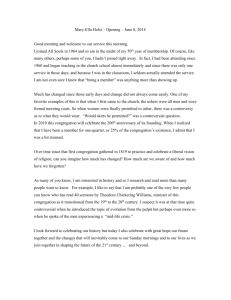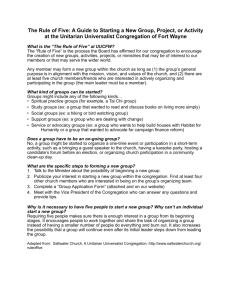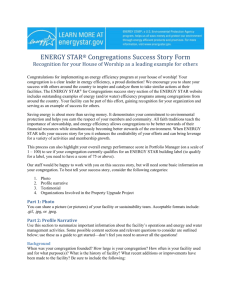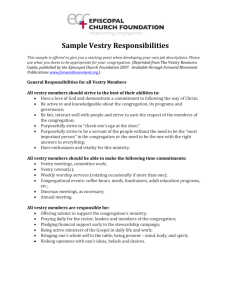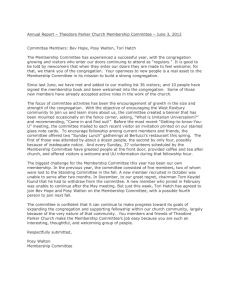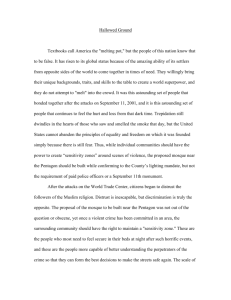Policy On Parish Financial Management
advertisement
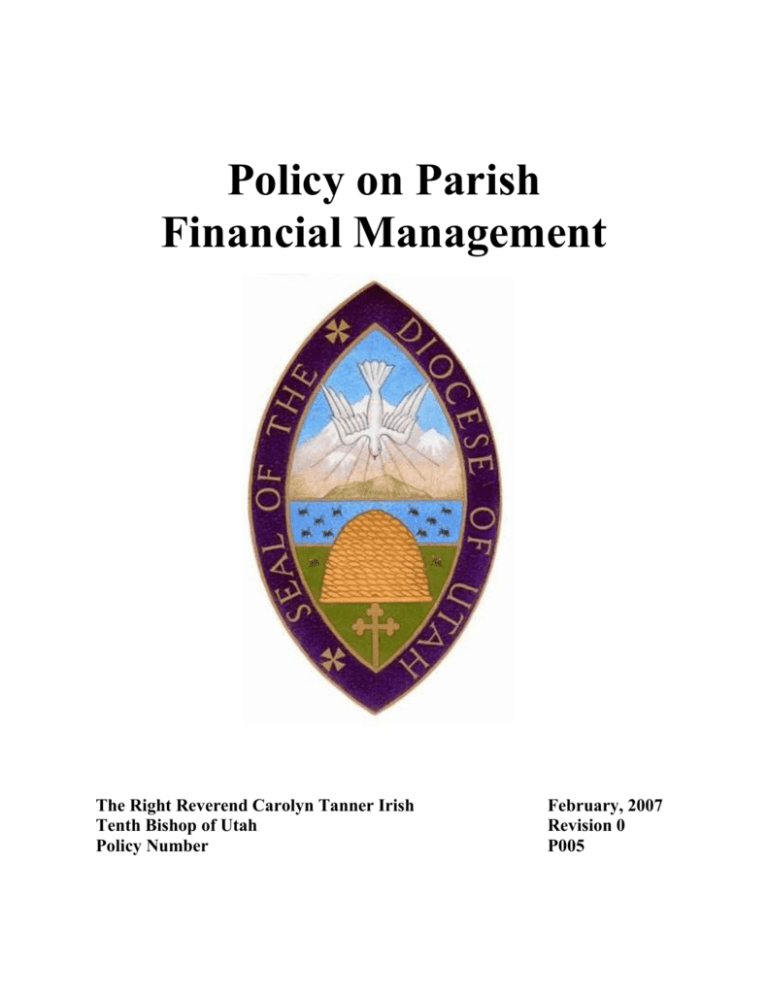
Policy on Parish Financial Management The Right Reverend Carolyn Tanner Irish Tenth Bishop of Utah Policy Number February, 2007 Revision 0 P005 The Episcopal Diocese of Utah Policy on Parish Financial Management Policy Number: P005 February 2007, Rev 0 PURPOSE This policy describes all aspects of financial management for congregations, including budgeting, accounting and bookkeeping, restricted and designated funds, financial reports, discretionary funds, and audits. The policies are designed to allow the congregation and the Diocese to work together to monitor the current financial status of the congregations and to anticipate and prepare for future needs. DEFINITIONS: ACCOUNT is a basic unit of double-entry bookkeeping. ACCRUAL ACCOUNTING is the preferred method for congregations. Revenue is reported when earned and expenses are reported in the period for which they are incurred. ASSETS are the accounts on the congregation’s Statement of Financial Position that represent the economic resources owned. AUDIT is a structured review of the congregation’s books of account to assure that financial statements are fairly stated, to protect the congregation’s assets and the persons handling the monies or investments of the congregation. CASH ACCOUNTING is an acceptable method for congregations. Revenue is reported when received and expenses are reported when paid. CHART OF ACCOUNTS is an account structure that allows for classification of transactions, preparation of financial statements, and appropriate budgeting. The chart of accounts should set up asset, liability, net asset, revenue, and expense accounts for each fund. DEPRECIATION is the method of reporting the use of assets. The cost of the asset is expensed over the period of its useful life, rather than fully at the time of acquisition. DESIGNATED ACCOUNT is one that has been designated for certain purposes by the Vestry. The Vestry can undesignate a designated account to use it for other purposes. DISCRETIONARY FUNDS are a class of temporarily restricted or designated funds, the expenditure of which is under the authority of the clergy person, to be used primarily to address the needs of the congregation and community members, in accordance with the Manual of Business methods in Church Affairs. DOUBLE-ENTRY BOOKKEEPING is a system whereby at least two offsetting entries must be made to record a transaction. The entries are referred to as DEBITS and CREDITS. At all times, the total amount of debits must equal the total amount of credits. If so, the books are said to be in balance. 1 The Episcopal Diocese of Utah Policy on Parish Financial Management Policy Number: P005 February 2007, Rev 0 ENDOWMENT FUND is one in which the principle of the fund is to be maintained inviolate, with only the income being available for use. The income may or may not be restricted as to its use. FUND is a self-balancing set of asset, liability, and net asset accounts. Funds are used to separate resources whose use may be limited by donors or Vestries. GAAP is the Generally Accepted Accounting Principles that require financial reports and accounting practices to follow certain guidelines. GENERAL LEDGER is a summary account book of all the accounts set up individually. LIABILITIES are the accounts on the congregation’s Statement of Financial Position that represent obligations to outsiders. MODIFIED ACCRUAL ACCOUNTING is an acceptable accounting method for congregations. Revenue and expenses are reported either using the cash or accrual method. Usually, expenses are reported using the accrual method and income is reported using the cash method. NET ASSETS are assets minus liabilities. They are equivalent to the retained earnings accounts for a commercial entity. RESTRICTED ACCOUNT is one that has been restricted for certain purposes by the donor. An account is TEMPORARILY RESTRICTED if the terms of its use can be affected by the completion of conditions. An account is PERMANENTLY RESTRICTED if the terms of its use are perpetual. The congregation is legally liable to ensure that the account is used according to the restrictions defined by the donor. REVENUES are the inflow of assets from contributions, sale of goods or services, and investments. STATEMENT OF FINANCIAL POSITION is the primary financial statement that provides information about the congregation’s assets, liabilities, and net assets, and about their relationship to each other at a particular point in time. The statement is sometimes called a Balance Sheet. STATEMENT OF ACTIVITIES provides information about: (1) the effects of transactions and other events and circumstances that change the amount and nature of net assets; (2) the relationship of those transactions or other events to each other; and (3) how the congregation’s resources are used in providing various programs and services. The statement is sometimes called the Income Statement or the Statement of Cash Receipts and Disbursements. 2 The Episcopal Diocese of Utah Policy on Parish Financial Management Policy Number: P005 February 2007, Rev 0 STATEMENT OF CASH FLOWS provides information about the cash receipts and disbursements classified as resulting from investing, financing, or operating activities. The statement is normally only prepared at year’s end. POLICY The Manual of Business Methods in Church Affairs, described above, provides helpful guidance on sound, practical business practices for congregations. Following the guidance and practices of the Manual will assist the congregation in complying with the statements of the Financial Accounting Standards Board, which governs generally accepted accounting principles (GAAP), and with the statements of the American Institute of Certified Public Accountants, which provides accounting and auditing standards. It is the policy of the Diocese of Utah that all congregations within the Diocese follow the practices set out in the Manual. Therefore, each congregation Treasurer and Vestry member should be familiar with the Manual. Similarly, Treasurers and Vestry members should be familiar with Title I, Canon 7, Of Business Methods in Church Affairs, 2006 National Canons. The following discussion is designed to summarize some of the most important points in the Manual, and at times to clarify or revise the Manual’s provisions to make them more applicable to the Diocese of Utah. Budgeting – see Manual, chapter I Budgeting is the allocation of the congregation’s resources for the achievement of its objectives and goals. A congregation must, therefore, have an understanding of its objectives and goals before creating a budget. The budget should be viewed along with the congregation’s bookkeeping and accounting systems, internal controls and procedures, the auditing process, and management oversight as a single system for proper stewardship of the congregation’s resources. Those congregations receiving assistance from the Diocese for operating funds must provide a draft budget to the Diocesan Finance Committee in time for inclusion in the Diocesan budgeting process, as it is defined each year by the Diocesan Council. All congregations, whether receiving Diocesan assistance or not, must provide a copy of the final, approved congregation budget to the Diocesan Minister of Finance, or similar position, within 30 days after the budget’s approval. In addition to the annual operating budget, congregations are encouraged to create and maintain a capital budget and an operating reserve. Note that these funds must be described in detail whenever the congregation makes a request for assistance from the Diocese. See Policy Numbers B002 – Parish Assessments and B003 – Parish Grants. 3 The Episcopal Diocese of Utah Policy on Parish Financial Management Policy Number: P005 February 2007, Rev 0 The capital budget considers the need to acquire, replace, or renovate the capital assets of the congregation. Capital reserves should be created sufficient to cover the anticipated needs of the congregation over the coming year. Amounts budgeted, but not spent, can carry over to the next budget. The operating reserve should consist of at least four month’s average monthly operating expense, to cover those times in the congregation’s life that actual income does not match anticipate income or when cash flow is insufficient to cover current expenses. Again, amounts budgeted, but not spent, can carry over to the next budget. Accounting and Bookkeeping – see Manual, chapter III Careful and accurate bookkeeping is the cornerstone of financial stewardship for the congregation. Many of the congregations in the Diocese of Utah use Church Windows and a template chart of accounts for their bookkeeping and reporting. Whatever system is used, it must allow for at least the following: Fund accounting Double-entry bookkeeping Cash receipts and disbursements journals Payroll (if necessary) Miscellaneous journal entries General Ledger Petty cash (if used) Funds transfers Discretionary funds Furniture, Fixtures, and Equipment Land and Buildings Depreciation Pledge reporting Month, quarter, and year-end closings Financial reporting Note that all money should be deposited to the general operating checking account as it is received. The money is recorded on the books as a credit to the appropriate fund – general operating, restricted, designated, special, etc. If the money should be physically transferred to a separate, special account, a check should be written from the general operating account to the separate account – savings, trusts, endowments, investments, etc. Restricted and Designated Funds – see Manual, chapter III; see also Policy Number P006 – Policy on Gift Acceptance. Gifts that have constraints or conditions imposed by the donor are restricted in use and should be segregated in the bookkeeping records. Similarly, monies that have been set 4 The Episcopal Diocese of Utah Policy on Parish Financial Management Policy Number: P005 February 2007, Rev 0 aside for a specific use by the Vestry are designated and should be segregated in the bookkeeping records. Note that restricted and designated funds need not necessarily be held in accounts separate from the general operating account. Separate bookkeeping entries are sufficient to maintain the segregation required of restricted and designated funds. If restricted or designated funds are kept in a common interest-bearing account, care must be taken to allocate accrued interest properly among the funds. Financial Reports – see Manual, chapter III The Vestry is responsible for the financial welfare of the congregation and for compliance with legal and canonical financial requirements. Therefore, the Treasurer must prepare financial reports for the Vestry, at least quarterly. The reports must include all funds of the congregation, including restricted and designated funds, in sufficient detail for the Vestry to exercise its fiduciary responsibilities, to make informed financial decisions, and to monitor progress in relationship to the budget. Congregations should use at least the following reports: Statement of Financial Position – with comparisons to the same time period of the previous year Statement of Activities – with comparisons with the budget, and at year’s end with comparisons to the prior year’s budget Statement of Cash Flows at year’s end Each congregation must send copies of its reports, at least quarterly, based on its fiscal year, to the Diocesan Minister of Finance, or similar position, Discretionary Funds – see Manual, chapter V Discretionary funds are temporarily restricted or designated funds, and must be accounted for as such. All checking accounts for discretionary funds must be approved by the Vestry, and must be opened using the congregation’s Federal Employer’s Identification Number. Bank accounts must be in the name of the congregation and not of the individual clergy. No deposits may be made directly into a separate discretionary account. All monies must be deposited in the congregation’s general operating account, recorded on the books, and then transferred, if appropriate, to the separate account. A person other than the one writing checks on the discretionary fund account should reconcile the account monthly. Discretionary funds are subject to audit and are included in the financial reports prepared for the Vestry. Discretionary funds stay with the congregation upon the departure of the clergy person. 5 The Episcopal Diocese of Utah Policy on Parish Financial Management Policy Number: P005 February 2007, Rev 0 Because discretionary funds belong to the congregation, and not to the individual cleric, the congregation should consider opening just one discretionary account for use by all of the congregation’s clergy. This suggestion will make accounting and auditing more simple. Audits/Records Reviews – see Manual, chapter VI Audits are required by the Canons of the Episcopal Church for all congregations, missions, and other institutions. The Episcopal Diocese of Utah and its affiliated entities, undergo an audit by an independent Certified Public Accountant each year. It is the policy of the Diocese that all congregations undergo an annual records review. Congregations that are self-supporting – receiving no financial assistance from the Diocese – must have an annual audit by an independent Certified Public Accountant at least every three (3) years, upon the departure of the rector or change of treasurer. In years in which no independent audit is conducted, the congregation must have a Committee Records Review, according to procedures approved by the Diocesan Council. Congregations and missions that are not self-supporting – receiving financial assistance from the Diocese – must have an annual Committee Records Review, according to procedures approved by the Diocesan Council, and upon the departure of the priest-in-charge. The Finance Committee is responsible for scheduling Committee Records Reviews, in cooperation with the congregation involved. All congregations must submit their final audits or budget reviews to the Diocesan Minister of Finance, or similar position, within 30 days after the audit or records review is received by the Vestry. 6

